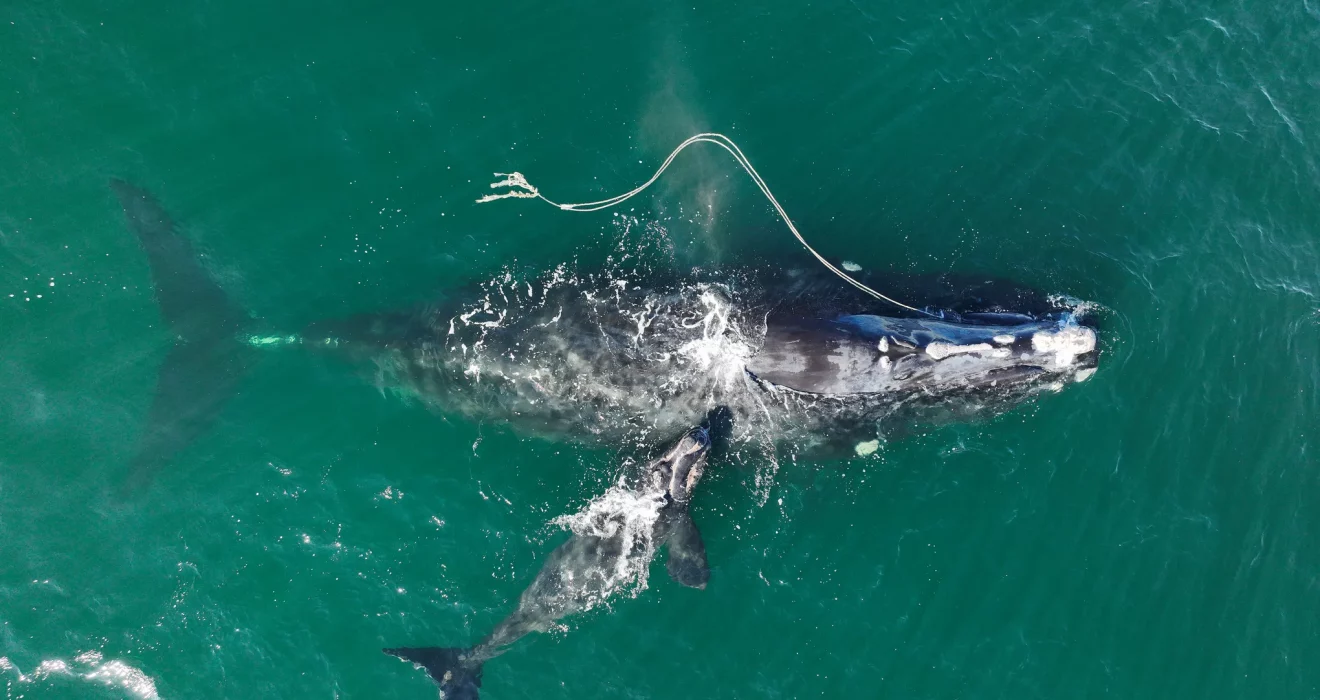In a momentous event that unfolds like a beacon of hope, the first North Atlantic right whale calf of the season has graced the waters off the coast of St. Catherines Sound in Georgia. This awe-inspiring discovery emerged as a result of a meticulous aerial survey conducted by the dedicated scientists from the Clearwater Marine Aquarium Research Institute (CMARI) on December 7. The significance of this sighting reverberates as a promising signal, marking the commencement of the eagerly anticipated 2022-2023 season for these majestic creatures.
As the scientists peered down from above, their efforts yielded a heartening spectacle – a mother and her newborn calf navigating the vast expanse of the ocean. The air of excitement and anticipation surrounds this event, underscoring the importance of such occurrences in the delicate ecosystem of the North Atlantic right whales. This sighting not only captivates our imaginations but serves as a reminder of the profound connection between human efforts, scientific vigilance, and the conservation of these critically endangered marine giants.
Meet Medusa: The Matriarch of Right Whale No. 1208
Meet Medusa, the esteemed matriarch of the North Atlantic right whales, specifically identified as right whale No. 1208. At the core of the recent sighting, Medusa stands as a distinguished mother, adding a touch of grace and significance to the unfolding narrative. With an estimated age of 42 years, Medusa has evolved into a noteworthy figure within the North Atlantic right whale community.
Her remarkable journey is punctuated by the recent joyous event – the birth of her seventh documented calf. This milestone not only underscores Medusa’s role as a seasoned parent but also provides a poignant glimpse into the intricate lives and enduring legacies within this endangered population. As a symbol of resilience and maternal prowess, Medusa embodies the challenges and triumphs faced by North Atlantic right whales in their ongoing struggle for survival.
In her presence, we witness the continuation of a lineage, a testament to the complexities of life beneath the ocean’s surface. Medusa’s story is not just an individual tale; it is a reflection of the broader narrative of these majestic creatures navigating the ever-changing dynamics of their marine environment.
Alarming Statistics of North Atlantic Right Whales
In the midst of the joy sparked by the recent sighting of the North Atlantic right whale calf, sobering statistics cast a shadow on the species’ future. These figures underline the precarious status of North Atlantic right whales, revealing a stark reality that demands urgent attention. With fewer than 350 individuals left and a mere count of less than 100 breeding females, the species finds itself perched on the brink of extinction.
This distressing situation has led to the classification of North Atlantic right whales as critically endangered on the International Union for the Conservation of Nature (IUCN) Red List. This designation places them among the most imperiled animals globally, accentuating the severity of the challenges they face. The dwindling numbers and scarcity of breeding females amplify the vulnerability of the species, intensifying the imperative for comprehensive conservation efforts to ensure their survival in the face of mounting threats.
Designated Critical Habitat Areas
In a proactive measure aimed at ensuring the survival of the North Atlantic right whales during their crucial calving period, designated critical habitat areas have been established along the coasts of Georgia, South Carolina, and northeast Florida. These designated zones serve as essential sanctuaries, playing a pivotal role in the ongoing conservation efforts for the endangered species.
The significance of these critical habitat areas lies in their role as protective havens for North Atlantic right whales during a vulnerable phase of their lifecycle. By designating specific regions, conservationists and authorities underscore a collective commitment to creating safe and conducive environments for the whales to give birth and nurture their offspring.
The collaborative efforts involved in establishing these critical habitat areas highlight the recognition of the shared responsibility in preserving the delicate balance of marine ecosystems. It reinforces the understanding that safeguarding these vital spaces is a collective endeavor, transcending geographical boundaries for the greater good of the North Atlantic right whale population. Through the designation of these sanctuaries, conservationists aspire to secure a sustainable future for the species, recognizing the interconnectedness of marine life and the need for concerted action in the face of environmental challenges.
Monitoring the Whales for Their Well-being
The CMARI team, led by James Powell, plays a pivotal role in protecting these whales through aerial surveys. Powell notes the historical trend of slow and steady recovery until 2010, with recent declines attributed to various factors, including a slow reproduction rate, entanglement in fishing gear, collisions with large vessels, and other potential unidentified threats.
Uphill Battle for North Atlantic Right Whales
Despite recent sightings, the ongoing threats to North Atlantic right whales persist. With rates of around 20 calves per season, the National Oceanic and Atmospheric Administration (NOAA) emphasizes the need for at least 50 calves annually for the species to recover. Vessel strikes and entanglement in fishing gear remain two primary challenges, causing agonizing injuries and mortality.
Urgent Measures Needed for Conservation
The need for immediate conservation measures becomes apparent as researchers work on developing ropeless fishing gear and collaborating with governments to mitigate vessel speeds and alter shipping lanes, particularly during migration seasons. As each identified North Atlantic right whale is cataloged, researchers give nicknames based on unique characteristics. Despite optimism surrounding each newborn calf, challenges persist, and urgent government intervention is essential to implement effective safeguards and secure the survival of these critically endangered whales.

